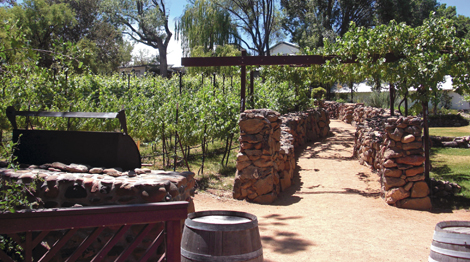From grape growing to award-winning pours, Arizona winemakers are proving that the altitudes of the Southwest are about much more than sweeping views of saguaros.

While the West Coast has been heralded for generations as home to some of the world’s most influential wine regions, Southwestern wineries have been steadily climbing up the ranks in terms of quality and visibility. For so long, the idea of producing a successful vino brand in the Arizona desert was thought to be an impossibility due to the region’s rough heat patterns and tough soils. According to the Arizona Wine Growers Association, the state’s wine prowess picked up steam in 1973 and since, three distinctly different wine regions have utilized sustained grape-growing techniques to beat the heat.
“The heat here is often like the south of Spain, Southern Italy and some of the other Mediterranean regions,” says Greg Tresner, master sommelier at The Phoenician. “The grape varietals grown there often work here too.” Tresner says that hot weather grapes, referred to in the wine industry as Rhone varietals for their prominence in Southeast France, are ideal for the production of warmer climate wines.
In addition to careful selection of grape types, Tresner says that Arizona grape growers have a myriad of tricks up their sleeves when it comes to yielding successful harvests each year. “What many people discovered and in particular Dr. [Gordon] Dutt, a pioneer of Arizona’s Sonoita Wine Country, is that techniques used in Europe—like south- and east-facing sloped vineyards—worked well in the higher altitudes around the state,” Tresner says. “Grape growers can adjust their vineyards so that areas with too much sun may be more northern facing and vice versa.” Vintners can also use leaf management by utilizing leaves on vines as shade providers or removing them in areas that need additional sunlight. “There are a lot of adjustments that you can do,” Tresner says. “But most importantly, perhaps, is the altitude. When you start getting up 4,000 feet above sea level, you get cooler temperatures.” It’s the cooler temperatures that make Arizona wines possible.
Verde Valley
Situated slightly south of Sedona, Verde Valley is Arizona’s northernmost wine region and encompasses areas of Cottonwood, Jerome and Cornville, among others.
Perhaps the most prominent winery in the region, Arizona Stronghold Vineyards, is deeply rooted in Southwestern culture and has three locations around the historic area—an 80-acre vineyard, a production facility and a tasting room in Old Town Cottonwood. The Phoenician stocks four wines from Arizona Stronghold. “They are our biggest sellers,” Tresner says. “People are really interested when it comes to indigenous products.”
Boasting a distinctly European essence, wines from the family-owned Page Springs Cellars in Verde Valley are of the land. Winemaker Eric Glomski produces syrah, petite sirah, mourvèdre and grenache that present characteristics of the Verde Valley in each sip.
Other must-visit wineries of the region: Alcantara Vineyards, Bitter Creek Winery, Caduceus Cellars, Freitas Vineyard, Javelina Leap Vineyard & Winery, Jerome Winery, Juniper Well Ranch Vineyards, Juniperwood Ranch Winery and Oak Creek Vineyards & Winery
Sonoita and Elgin
As the only designated viticulture area in Arizona, the Sonoita region’s wine menu is more mature than others in the state. “Sonoita is more developed because there is some red soil down there and you can see that in the earthy, mineral qualities of the red wines produced there,” Tresner says.
If you are an Arizona wine connoisseur, the name Dr. Gordon Dutt probably means a thing or two. Partnering with the University of Arizona for research in the 1970’s, Dr. Dutt was integral in helping to grow an understanding about the science of Arizona’s soil. “I met Dr. Dutt, who started Sonoita Vineyards, and he did a lot of experimenting in terms of altitude in desert climates,” Tresner says. “What he discovered has had a big influence on what is going on today.”
Following his research, Dutt founded Sonoita Vineyards, which opened its doors in 1983. From cabernet sauvignon and merlot to syrah and everything in between, the 25-acre property produces more than 10,000 gallons of wine each year.
Located in the town of Elgin, Callaghan Vineyards has produced superior quality, award-winning wines since opening in 1990. Callaghan produces anenticing array of Mediterranean and Spanish varietals, which visitors can try from 11 a.m. to 3 p.m. Friday through Sunday.
Other must-visit wineries of the region: Canelo Hills Vineyard & Winery, Charron Vineyard, Dos Cabezas Wineworks, Kief-Joshua Vineyards, Lightning Ridge Cellars, Rancho Rossa Vineyards, The Village of Elgin Winery and Wilhelm Family Vineyards
Willcox
While most make their way to Willcox in southern Arizona in search of old charm, desert history and antique shops galore, the quaint town is also brimming with veteran vintners.
With more than a decade of winemaking experience, the wines from Keeling Schaefer Vineyards have grown to success via family farming roots that date back to the 1920’s. The winery’s 2006 Three Sisters Syrah, 2007 Two Reds Grenache and 2008 Best Friends Chardonnay have been rated among the highest in Arizona and have even received nods from the Wall Street Journal.
If a wide selection of wines is a must for a day tasting at the vineyards, then the impressive wine list at Coronado Vineyards is sure to delight. From sweet sparkling wines to chardonnays and an award-winning cabernet, visitors can appreciate wine pairings from Coronado Vineyards at its onsite restaurant, open selected days throughout the week. “When you go to visit wineries, it is not like hello, goodbye,” Tresner says. “People enjoy your interest and it is a very cordial, hospitable group of people who are in the wine and vineyard-growing business.”
Other must-visit wineries of the region: Carlson Creek Vineyard, Cimarron Vineyards, Lawrence Dunham Vineyards, Pillsbury Wine Company and Sierra Bonita Vineyards